tow AUDI Q3 2019 Service Manual
[x] Cancel search | Manufacturer: AUDI, Model Year: 2019, Model line: Q3, Model: AUDI Q3 2019Pages: 280, PDF Size: 72.73 MB
Page 212 of 280
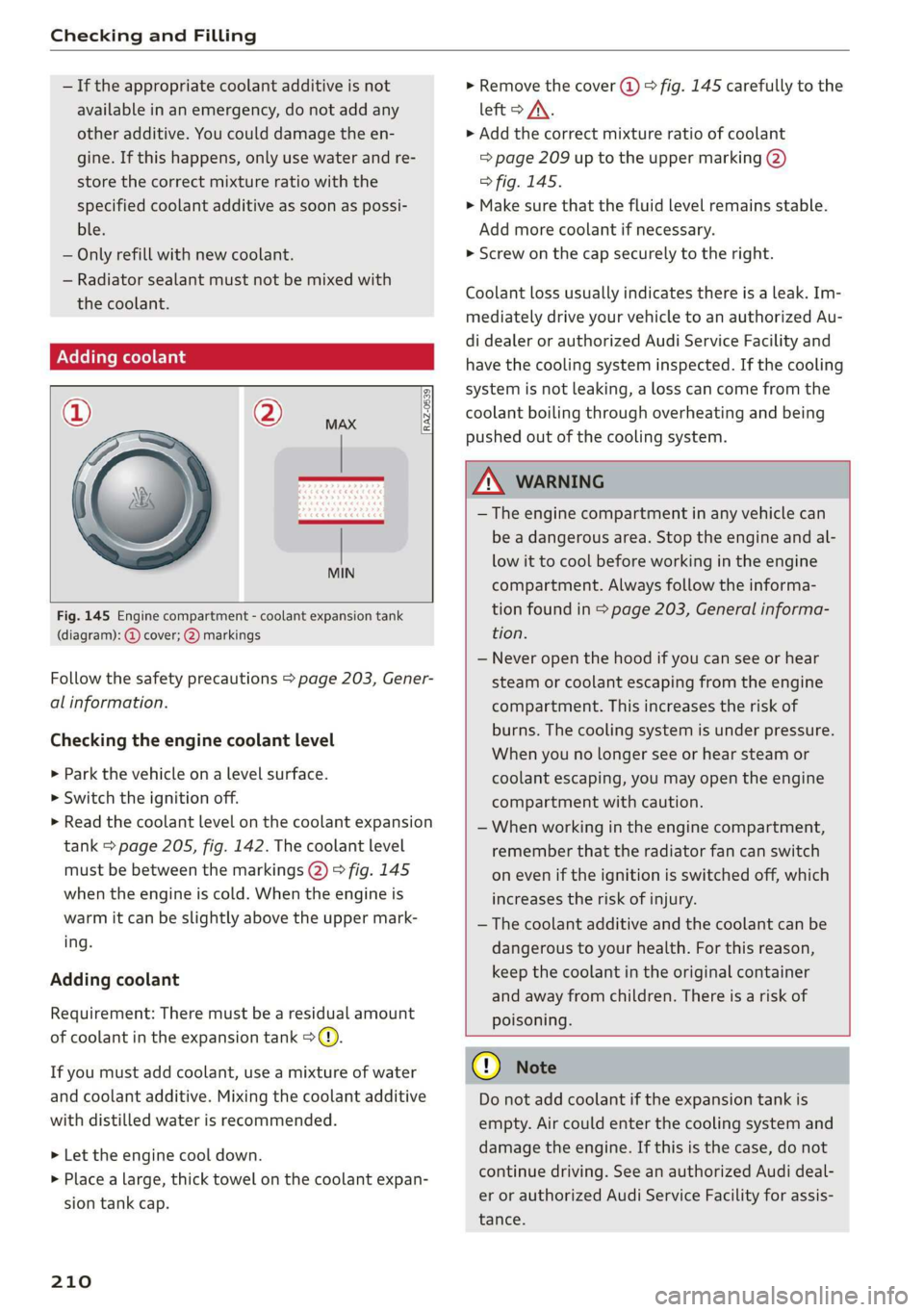
Checking and Filling
— If the appropriate coolant additive is not
available in an emergency, do not add any
other additive. You could damage the en-
gine. If this happens, only use water and re-
store the correct mixture ratio with the
specified coolant additive as soon as possi-
ble.
— Only refill with new coolant.
— Radiator sealant must not be mixed with
the coolant.
Adding coolant
RAZ-0539
Fig. 145 Engine compartment - coolant expansion tank
(diagram): @ cover; @) markings
Follow the safety precautions > page 203, Gener-
al information.
Checking the engine coolant level
>» Park the vehicle on a level surface.
> Switch the ignition off.
> Read the coolant level on the coolant expansion
tank > page 205, fig. 142. The coolant level
must be between the markings @) 9 fig. 145
when the engine is cold. When the engine is
warm it can be slightly above the upper mark-
ing.
Adding coolant
Requirement: There must be a residual amount
of coolant in the expansion tank >@).
If you must add coolant, use a mixture of water
and coolant additive. Mixing the coolant additive
with distilled water is recommended.
> Let the engine cool down.
> Place a large, thick towel on the coolant expan-
sion tank cap.
210
» Remove the cover (@) > fig. 145 carefully to the
left > AX.
» Add the correct mixture ratio of coolant
> page 209 up to the upper marking @)
> fig. 145.
> Make sure that the fluid level remains stable.
Add more coolant if necessary.
> Screw on the cap securely to the right.
Coolant loss usually indicates there is a leak. Im-
mediately drive your vehicle to an authorized Au-
di dealer or authorized Audi Service Facility and
have the cooling system inspected. If the cooling
system is not leaking, a loss can come from the
coolant boiling through overheating and being
pushed out of the cooling system.
ZA WARNING
— The engine compartment in any vehicle can
be a dangerous area. Stop the engine and al-
low it to cool before working in the engine
compartment. Always follow the informa-
tion found in > page 203, General informa-
tion.
— Never open the hood if you can see or hear
steam or coolant escaping from the engine
compartment. This increases the risk of
burns. The cooling system is under pressure.
When you no longer see or hear steam or
coolant escaping, you may open the engine
compartment with caution.
— When working in the engine compartment,
remember that the radiator fan can switch
on even if the ignition is switched off, which
increases the risk of injury.
— The coolant additive and the coolant can be
dangerous to your health. For this reason,
keep the coolant in the original container
and away from children. There is a risk of
poisoning.
@) Note
Do not add coolant if the expansion tank is
empty. Air could enter the cooling system and
damage the engine. If this is the case, do not
continue driving. See an authorized Audi deal-
er or authorized Audi Service Facility for assis-
tance.
Page 231 of 280
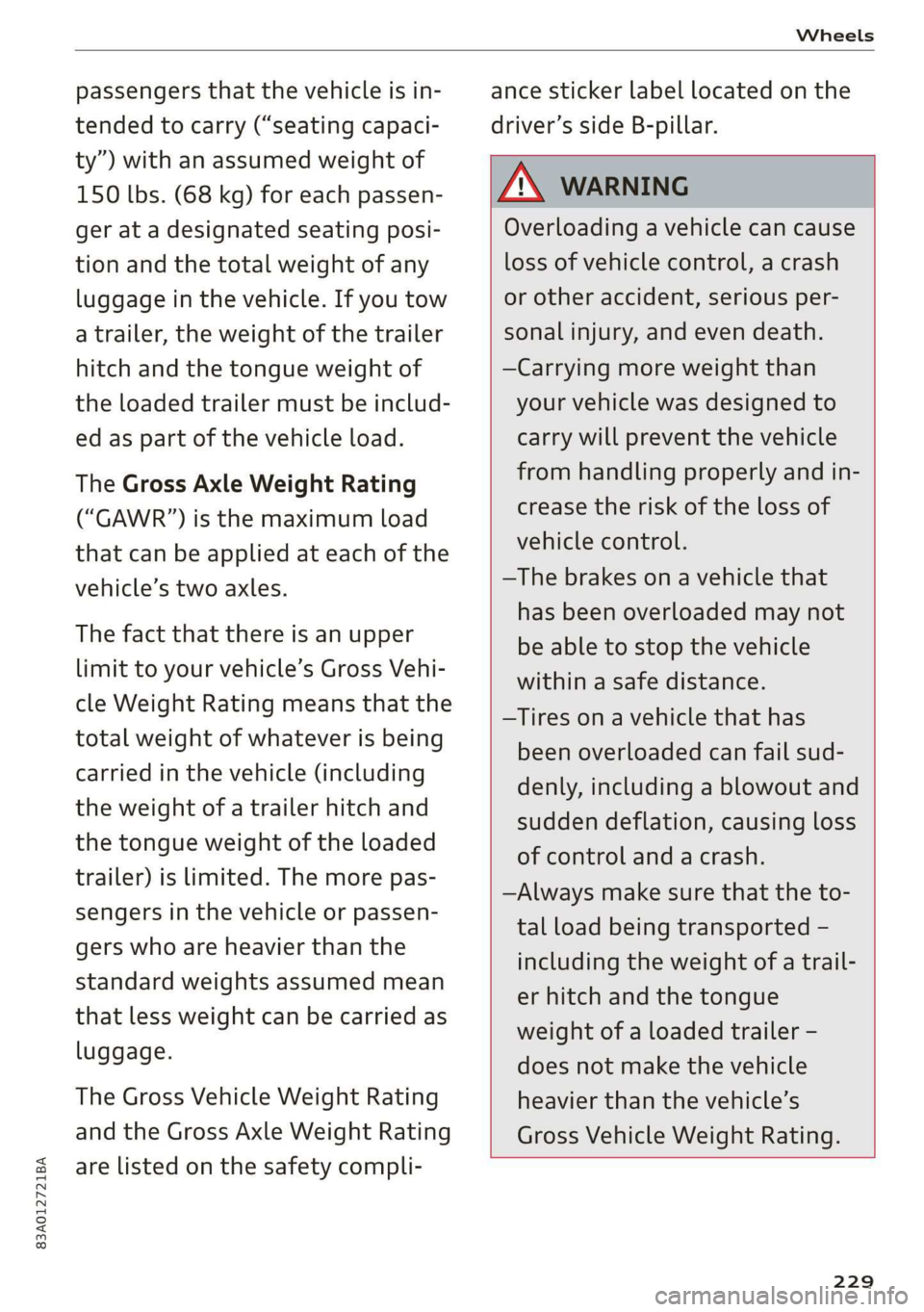
83A012721BA
Wheels
passengers that the vehicle is in-
tended to carry (“seating capaci-
ty”) with an assumed weight of
150 lbs. (68 kg) for each passen-
ger at a designated seating posi-
tion and the total weight of any
luggage in the vehicle. If you tow
a trailer, the weight of the trailer
hitch and the tongue weight of
the loaded trailer must be includ-
ed as part of the vehicle load.
The Gross Axle Weight Rating
(“GAWR”) is the maximum load
that can be applied at each of the
vehicle’s two axles.
The fact that there is an upper
limit to your vehicle’s Gross Vehi-
cle Weight Rating means that the
total weight of whatever is being
carried in the vehicle (including
the weight of a trailer hitch and
the tongue weight of the loaded
trailer) is limited. The more pas-
sengers in the vehicle or passen-
gers who are heavier than the
standard weights assumed mean
that less weight can be carried as
luggage.
The Gross Vehicle Weight Rating
and the Gross Axle Weight Rating
are listed on the safety compli-
ance sticker label located on the
driver’s side B-pillar.
AN WARNING
Overloading a vehicle can cause
loss of vehicle control, a crash
or other accident, serious per-
sonal injury, and even death.
—Carrying more weight than
your vehicle was designed to
carry will prevent the vehicle
from handling properly and in-
crease the risk of the loss of
vehicle control.
—The brakes on a vehicle that
has been overloaded may not
be able to stop the vehicle
within a safe distance.
—Tires ona vehicle that has
been overloaded can fail sud-
denly, including a blowout and
sudden deflation, causing loss
of control and a crash.
—Always make sure that the to-
tal load being transported -
including the weight of a trail-
er hitch and the tongue
weight of a loaded trailer -
does not make the vehicle
heavier than the vehicle’s
Gross Vehicle Weight Rating.
229
Page 232 of 280
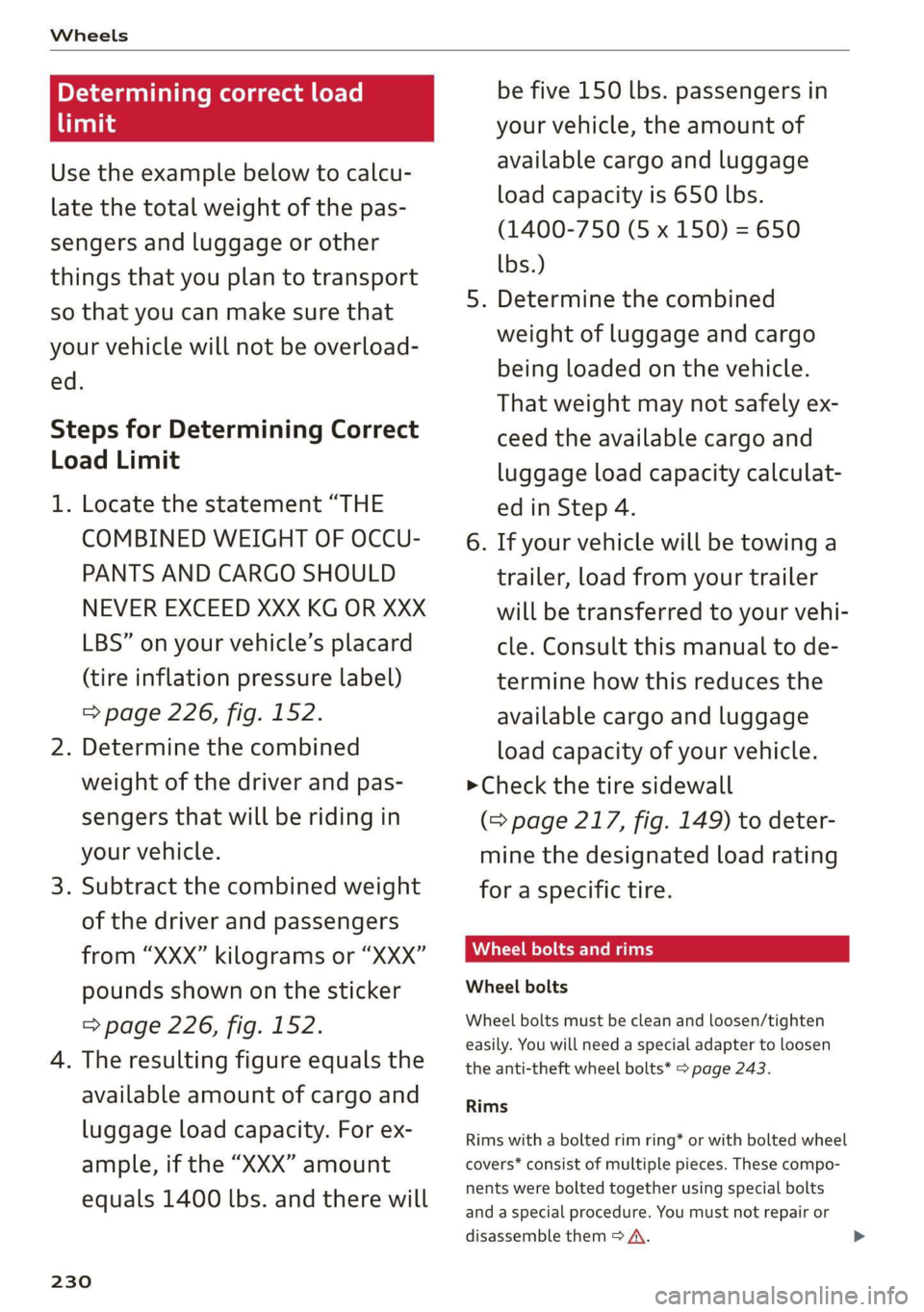
Wheels
Determining correct load
limit
Use the example below to calcu-
late the total weight of the pas-
sengers and luggage or other
things that you plan to transport
so that you can make sure that
your vehicle will not be overload-
ed.
Steps for Determining Correct
Load Limit
1. Locate the statement “THE
COMBINED WEIGHT OF OCCU-
PANTS AND CARGO SHOULD
NEVER EXCEED XXX KG OR XXX
LBS” on your vehicle’s placard
(tire inflation pressure label)
=> page 226, fig. 152.
2. Determine the combined
weight of the driver and pas-
sengers that will be riding in
your vehicle.
3. Subtract the combined weight
of the driver and passengers
from “XXX” kilograms or “XXX”
pounds shown on the sticker
=> page 226, fig. 152.
4. The resulting figure equals the
available amount of cargo and
luggage load capacity. For ex-
ample, if the “XXX” amount
equals 1400 lbs. and there will
230
be five 150 lbs. passengers in
your vehicle, the amount of
available cargo and luggage
oad capacity is 650 lbs.
(1400-750 (5 x 150) = 650
bs.)
5. Determine the combined
weight of luggage and cargo
being loaded on the vehicle.
That weight may not safely ex-
ceed the available cargo and
uggage load capacity calculat-
ed in Step 4.
6. If your vehicle will be towing a
trailer, load from your trailer
will be transferred to your vehi-
cle. Consult this manual to de-
termine how this reduces the
available cargo and luggage
load capacity of your vehicle.
>Check the tire sidewall
(=> page 217, fig. 149) to deter-
mine the designated load rating
for a specific tire.
Wheel bolts and rims
Wheel bolts
Wheel bolts must be clean and loosen/tighten
easily. You will need a special adapter to loosen
the anti-theft wheel bolts* > page 243.
Rims
Rims with a bolted rim ring* or with bolted wheel
covers* consist of multiple pieces. These compo-
nents were bolted together using special bolts
and a special procedure. You must not repair or
disassemble them > A\.
Page 244 of 280
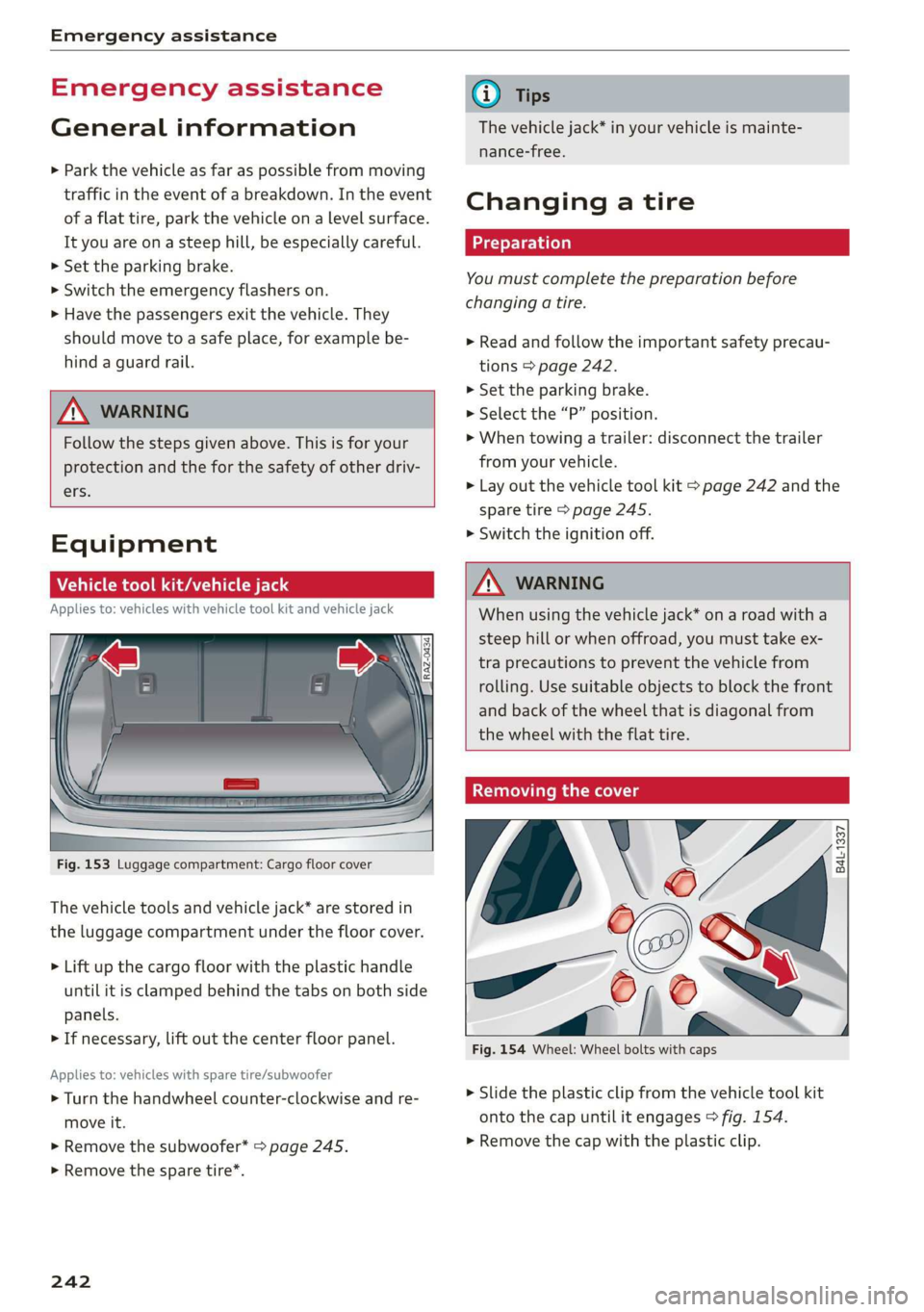
Emergency assistance
Emergency assistance
General information
> Park the vehicle as far as possible from moving
traffic in the event of a breakdown. In the event
of a flat tire, park the vehicle ona level surface.
It you are ona steep hill, be especially careful.
> Set the parking brake.
> Switch the emergency flashers on.
> Have the passengers exit the vehicle. They
should move to a safe place, for example be-
hind a guard rail.
Z\ WARNING
Follow the steps given above. This is for your
protection and the for the safety of other driv-
ers.
Equipment
Vehicle tool kit/vehicle jack
Applies to: vehicles with vehicle tool kit and vehicle jack
Fig. 153 Luggage compartment: Cargo floor cover
The vehicle tools and vehicle jack* are stored in
the luggage compartment under the floor cover.
> Lift up the cargo floor with the plastic handle
until it is clamped behind the tabs on both side
panels.
> If necessary, lift out the center floor panel.
Applies to: vehicles with spare tire/subwoofer
> Turn the handwheel counter-clockwise and re-
move it.
> Remove the subwoofer* > page 245.
> Remove the spare tire*.
242
@ Tips
The vehicle jack* in your vehicle is mainte-
nance-free.
Changing a tire
You must complete the preparation before
changing a tire.
> Read and follow the important safety precau-
tions > page 242.
> Set the parking brake.
> Select the “P” position.
>» When towing a trailer: disconnect the trailer
from your vehicle.
> Lay out the vehicle tool kit > page 242 and the
spare tire > page 245.
> Switch the ignition off.
Z\ WARNING
When using the vehicle jack* on a road with a
steep hill or when offroad, you must take ex-
tra
precautions to prevent the vehicle from
rolling. Use suitable objects to block the front
and back of the wheel that is diagonal from
the wheel with the flat tire.
Removing the cover
\
i
Fig. 154 Wheel: Wheel bolts with caps
X
me) 4
> Slide the plastic clip from the vehicle tool kit
onto the cap until it engages > fig. 154.
> Remove the cap with the plastic clip.
Page 250 of 280
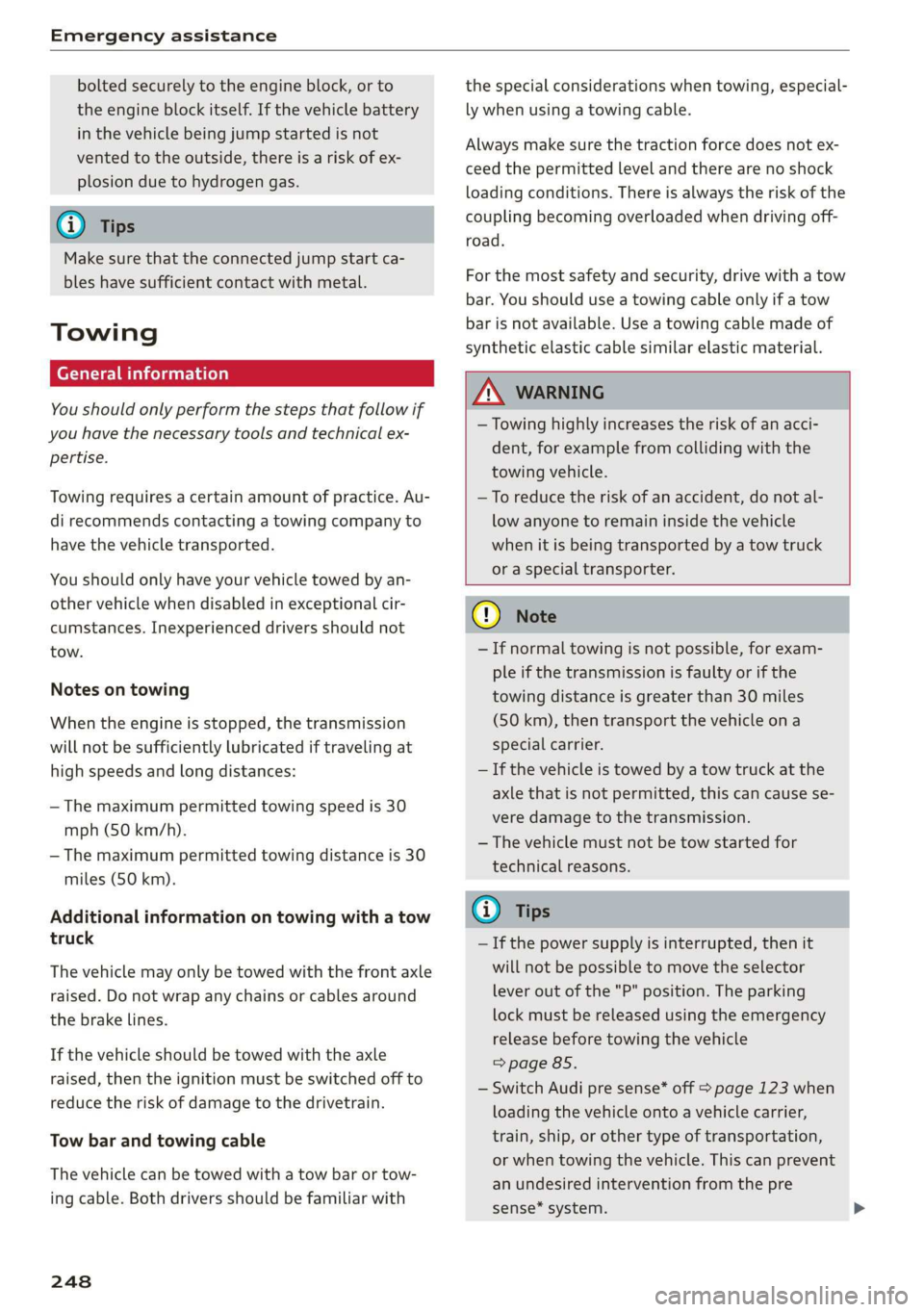
Emergency assistance
bolted securely to the engine block, or to
the engine block itself. If the vehicle battery
in the vehicle being jump started is not
vented to the outside, there is a risk of ex-
plosion due to hydrogen gas.
Gi) Tips
Make sure that the connected jump start ca-
bles have sufficient contact with metal.
Towing
erasure)
You should only perform the steps that follow if
you have the necessary tools and technical ex-
pertise.
Towing requires a certain amount of practice. Au-
di recommends contacting a towing company to
have the vehicle transported.
You should only have your vehicle towed by an-
other vehicle when disabled in exceptional cir-
cumstances. Inexperienced drivers should not
tow.
Notes on towing
When the engine is stopped, the transmission
will not be sufficiently lubricated if traveling at
high speeds and long distances:
— The maximum permitted towing speed is 30
mph (50 km/h).
— The maximum permitted towing distance is 30
miles (50 km).
Additional information on towing with a tow
truck
The vehicle may only be towed with the front axle
raised. Do not wrap any chains or cables around
the brake lines.
If the vehicle should be towed with the axle
raised, then the ignition must be switched off to
reduce the risk of damage to the drivetrain.
Tow bar and towing cable
The vehicle can be towed with a tow bar or tow-
ing cable. Both drivers should be familiar with
248
the special considerations when towing, especial-
ly when using a towing cable.
Always make sure the traction force does not ex-
ceed the permitted level and there are no shock
loading conditions. There is always the risk of the
coupling becoming overloaded when driving off-
road.
For the most safety and security, drive with a tow
bar. You should use a towing cable only if a tow
bar is not available. Use a towing cable made of
synthetic elastic cable similar elastic material.
ZA\ WARNING
— Towing highly increases the risk of an acci-
dent, for example from colliding with the
towing vehicle.
—To reduce the risk of an accident, do not al-
low anyone to remain inside the vehicle
when it is being transported by a tow truck
or a special transporter.
@) Note
— If normal towing is not possible, for exam-
ple if the transmission is faulty or if the
towing distance is greater than 30 miles
(50 km), then transport the vehicle on a
special carrier.
— If the vehicle is towed by a tow truck at the
axle that is not permitted, this can cause se-
vere damage to the transmission.
— The vehicle must not be tow started for
technical reasons.
(i) Tips
— If the power supply is interrupted, then it
will not be possible to move the selector
lever out of the "P" position. The parking
lock must be released using the emergency
release before towing the vehicle
> page 85.
— Switch Audi pre sense* off > page 123 when
loading the vehicle onto a vehicle carrier,
train, ship, or other type of transportation,
or when towing the vehicle. This can prevent
an undesired intervention from the pre
sense* system.
Page 251 of 280
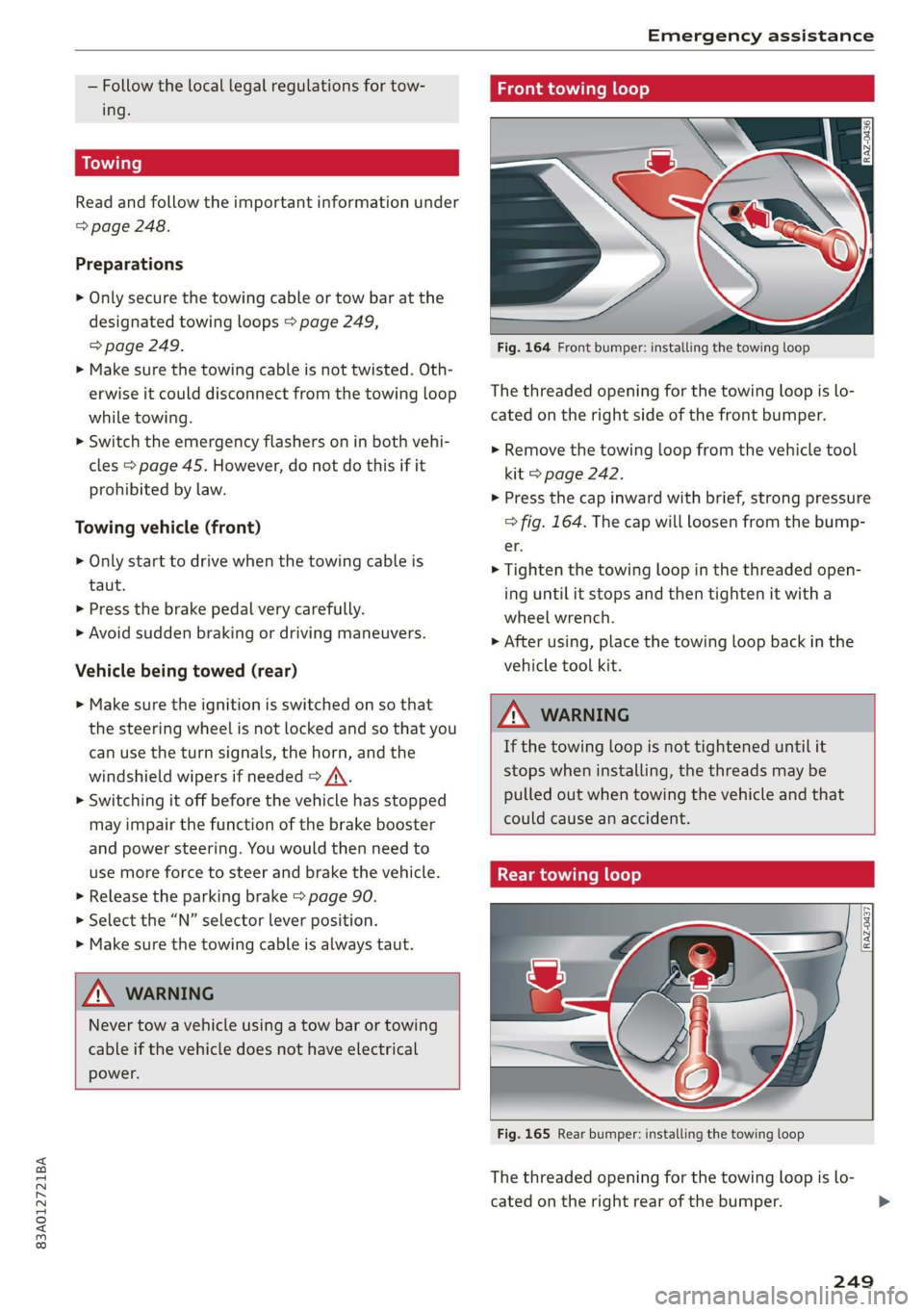
83A012721BA
Emergency assistance
— Follow the local legal regulations for tow-
ing.
Read and follow the important information under
=> page 248.
Preparations
> Only secure the towing cable or tow bar at the
designated towing loops > page 249,
=> page 249.
> Make sure the towing cable is not twisted. Oth-
erwise it could disconnect from the towing loop
while towing.
> Switch the emergency flashers on in both vehi-
cles > page 45. However, do not do this if it
prohibited by law.
Towing vehicle (front)
> Only start to drive when the towing cable is
taut.
> Press the brake pedal very carefully.
> Avoid sudden braking or driving maneuvers.
Vehicle being towed (rear)
> Make sure the ignition is switched on so that
the steering wheel is not locked and so that you
can use the turn signals, the horn, and the
windshield wipers if needed > A\.
> Switching it off before the vehicle has stopped
may impair the function of the brake booster
and power steering. You would then need to
use more force to steer and brake the vehicle.
> Release the parking brake > page 90.
> Select the “N” selector lever position.
> Make sure the towing cable is always taut.
A WARNING
Never tow a vehicle using a tow bar or towing
cable if the vehicle does not have electrical
power.
Front towing loop
Fig. 164 Front bumper: installing the towing loop
The threaded opening for the towing loop is lo-
cated on the right side of the front bumper.
> Remove the towing loop from the vehicle tool
kit > page 242.
> Press the cap inward with brief, strong pressure
> fig. 164. The cap will loosen from the bump-
er.
> Tighten the towing loop in the threaded open-
ing until it stops and then tighten it with a
wheel wrench.
> After using, place the towing loop back in the
vehicle tool kit.
ZX WARNING
If the towing loop is not tightened until it
stops when installing, the threads may be
pulled out when towing the vehicle and that
could cause an accident.
Rear towing loop
Fig. 165 Rear bumper: installing the towing loop
The threaded opening for the towing loop is lo-
cated on the right rear of the bumper.
249
Page 252 of 280
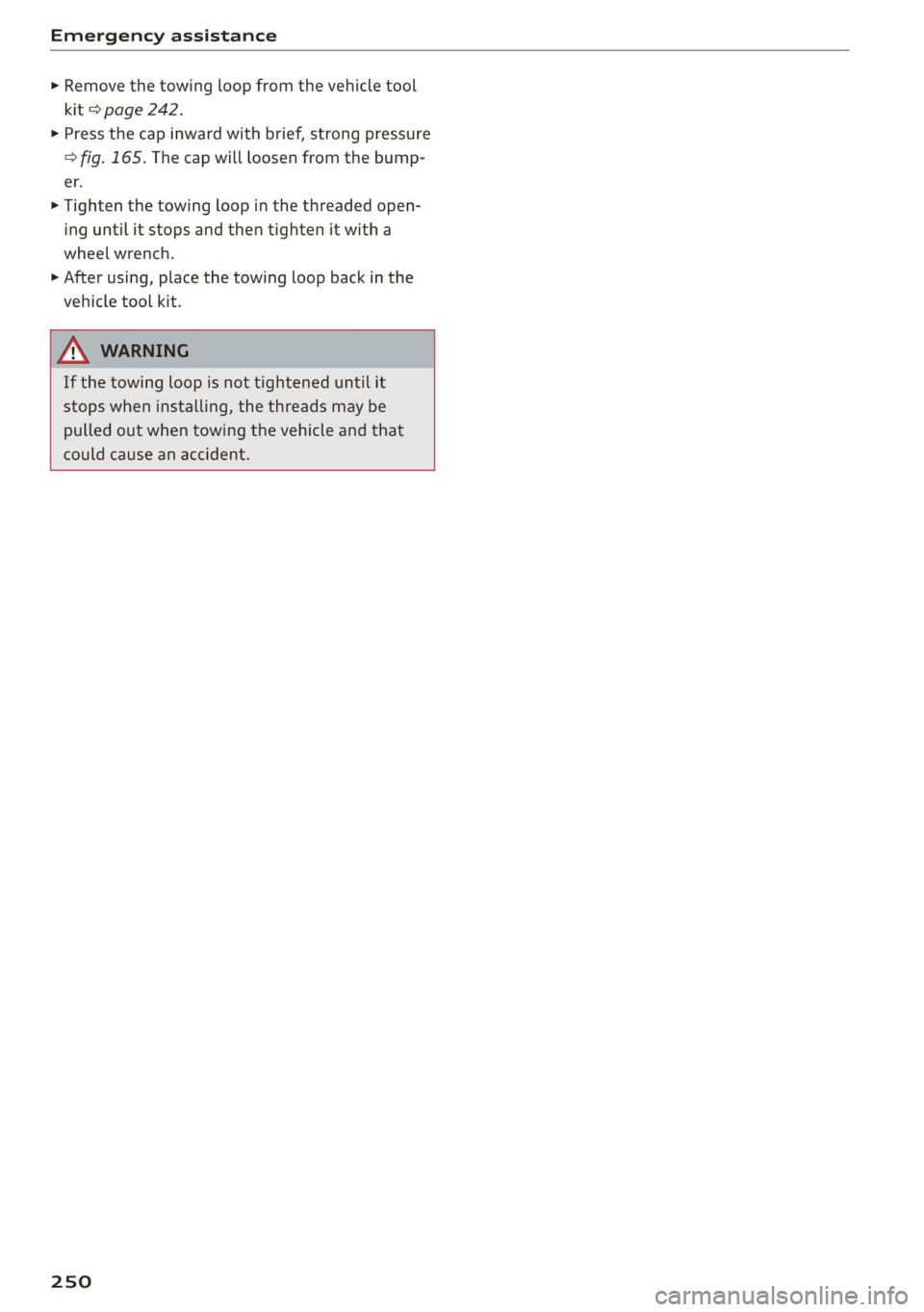
Emergency assistance
> Remove the towing loop from the vehicle tool
kit > page 242.
> Press the cap inward with brief, strong pressure
> fig. 165. The cap will loosen from the bump-
er.
> Tighten the towing loop in the threaded open-
ing until it stops and then tighten it with a
wheel wrench.
> After using, place the towing loop back in the
vehicle tool kit.
ZA, WARNING
If the towing loop is not tightened until it
stops when installing, the threads may be
pulled out when towing the vehicle and that
could cause an accident.
250
Page 276 of 280

Index
Software information
Legalinformation..............0.0005 197
Software version (MMI)
Version information.................. 197
Sound
refer to Adjusting the sound............ 195
Space-saving spare tire (compact spare tire) . 245
SParGuites = 5 mane < 5 Hane & BES GF Heme G = He 245
Speedometer........... 0. cece eee eee ee 11
Speed warning systeM...... 0... e eee eee 108
Start/Stop systeM......... 0.0 cece eee 87
Switching offandon...............0--- 88
Starting to drive............ cee eee eee 82,92
Starting (engine).................. eee 88
Steering... 6... eee cee eee ee 97
Audi drive select...............000000. 96
alsoreferto Steering: « «cans se cas vs cae 97
St@ering lock: s < sass ss peas ss ewe s 80, 81,97
Steering wheel
ACjUSEING sie © 2 wenn oe ware 2 oe = eeeD oo 56
Adjusting manually..................0- 56
SHITE Paddles « ssras + ¢ aime & ¥ cease 3 x eS ae 84
Steering wheel heating................. 79
also refer to Multifunction steering wheel. . 12
Steps for determining correct load limit... 230
Stopover (navigation) ................-. 164
StOPPiNG (ENGINE) we. o 6 sees eo owen oo er a a 88
StOraG@ zs 5 « wewe ¢ 5 sews & eee s eo ee 73, 74
Storage bag = sess + eae% ¢ = Hees « ¢ eee ¥ gore 73
Storage compartment................... 73
Stored stations
Feferto FAVOrites . xen s « wows 2 x om s 2 oe 177
Streaming
refer to Online media................. 183
SubWOOfEr’s casaz x s saws 2 & mewn 2 9 wei 3 owe 245
Sunshade
refer to Sunshade (roof)..............-. 39
Sunshade ((0Of) sieisie es sssvee sv wae ov eww w 39
SUN'WISOIS » saw + game g » yeu gs ream ao eee se 48
SUSPENSION sacs 3 3 neue ss eooey 4 Fao 3 & BOERS 96
Audi drive select..............02--000- 96
Swap Call sswiec «2 nein 2 v eve 2 o aren ¥ a ee 147
Symbols
274
System Settings « vce ss cece wv serene vv ereseee 195
T
Tachomete@ tics: a 2 esse se crac sv ew 2 oo i, 13
Tail lights
Cleaning... ...... cee cece 237
Techinicalidatiay, « « wssess sa senine aw soanine 0 w avews 263
Technical modifications................. 258
Telephones « vases s eee ss gern se oes x es 139
Audi phone box..............2-0000ee 141
Dialing anumber.................2005 146
Options during aphonecall............ 147
PlayiMgeMUsie « cemese x o snenece « semen « 0 svete « 182
Temperature display
Coolant... 6... cece eee eee eee eee 11
Temperature display (outside temperature).. 14
TexXteINPUt s sncsene a + soccnme w 6 avon » 6 soem © w veneer 22
Text messages
Message options................00005 147
SOttinGS
scan « = seuss « y peux 2 ¢ eG «ee 147
also refer to Text messages............ 147
Tie*dowtise « » sams 2 2 gee 2 qamom ¢ « ween & 3 eee 75
Tightening specification
Wheel. Bolt staves 2 vscsie oo wna 2 0 onivaue w ¥ emus 245
Tightening specification (wheel bolts) .... . 245
Tit@ss « ¢ ewes = ¢ qews + 2 pew se eg ae a a 14
tiptronic
refer to Manual shifting................ 84
TPES = scwssn 2 > wrsee oo mie 2 oe ov ER wo 216
CHAM GIIAG psu + vssnnas ov ensues © & enetane oH wtmuene © 242
Loose wheel warning.............-.... 231
LOWsprovile
tires » www 2 2 caww a e wees s 2 xe 232
Service UiFE an avenina 0 a sneane a 4 axmuane «9 sme 225
Tire pressure... 2.2... 0c eee eee eee eee 226
Tire pressure monitoring system.... 233, 234
Tire pressure table.................0.. 227
Tire pressure (trailer towing)........... 101
Treadwear indicators...............0.. 225
Unidirectional...............0.2. 218, 245
Uniform tire quality grading............ 233
Tires and wheels
Glossary of tire and loading terminology... 219
Tires and vehicle load limits............ 228
TO0ks ¢ cies « 2 spams ¢ 2 caw «epee ¥ ore x 8 242
Top tether anchor (securing the child safety
SQAE) se 2 a cwcvese + savers eo vases =H ateeoes =H cree a 69
Page 277 of 280
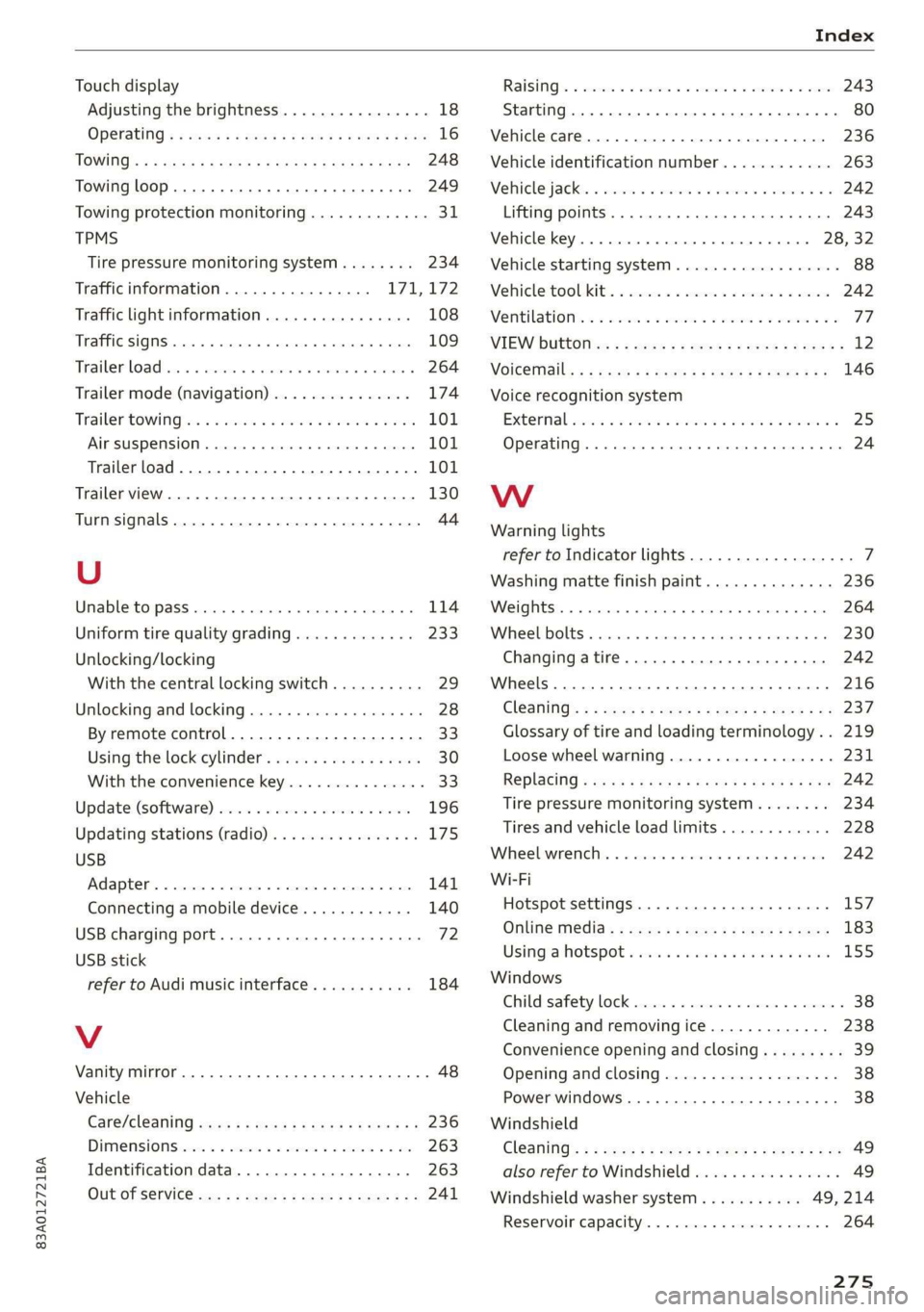
83A012721BA
Touch display
Adjusting the brightness..............-. 18
TPMS
Tire pressure monitoring system........ 234
Traffic information................ 171,172
Traffic light information.............005 108
Traffic SIGNS 6.6... eee 109
Tatler loadisas x sisaws «x anens » ¥ sesens © « vanzens 9 264
Trailer mode (navigation) ............... 174
Trailer towing ies «2 sess 2s eves oe sew 2 eee 101
Air suspension...........0e eee eee eee 101
Trailer load... 2... eee eee eee eee 101
Trailer view.............22-.222.2020000005 130
Turn signals. ......... 0... e eee eee eee 44
U
Unable to pass.............0 0.000 e eee 114
Uniform tire quality grading............. 233
Unlocking/locking
With the central locking switch.......... 29
Unlocking and locking.............000005 28
By remote control.............--.000-5 33
Using thelockeylinders owes» s wae ae enn 30
With the convenience key............... 33
Updater (software) sisi 0 «seve w seamne o © sueiaue 196
Updating stations (radio)................ 175
USB
Adapter. .... 0.00. .c cee eee eee eee 141
Connecting a mobile device............ 140
USB charging port..................0005 72
USB stick
refer to Audi music interface........... 184
V
Vanity mirror... 22... eee eee eee eee 48
Vehicle
Carée/cleaning sensu < » eas sv eee e weeew ee 236
DiMeNSIONS esc co cvesees wo miaens vw enemas 6 w oe 263
Identification data................... 263
OUTOTSERVICE ce = x wows 2: wane xy Gee go: 241
RaiSig’s « cxssce v cssuane oo cavewce wow comeee ¥ & osmee 243
Starting... 2... cece eee 80
Vehicle care... 2 eee ee eee 236
Vehicle identification number............ 263
Vehicle jack. csoie se scenes 2 v envice 2 v ene 2 ae 242
Lifting points. ............ 0.0 e eee eee 243
Vehicle key. 1... . cece eee eee 28, 32
Vehicle starting system...............00. 88
Vehicle:tool:kitss «cesses v wacne ae enw ao eer 242
Ventilation’: «= sss os wwen os xeon 2 ¥ ecw x Ho 77
VIEW butt0ttes « = saws = 5 eeu peewee sees 12
Voicetiails: = s segs « = wees oe eoree + e wae 2 146
Voice recognition system
External scsi +o meee a wan ov ween ao wee 2 25
Operating. ..... 0... 0c cece eee eee 24
Ww
Warning lights
refer to Indicator lights...............-0. 7
Washing matte finish paint.............. 236
WEIGHESE: « « ccosase o asemie « eooren 9 0 onanens 0 0 one 264
Wheelibolt x cesccss 2 x sve « 0 snnuens oo onecnae #0 « 230
Changing atire.............. ee ee eee 242
Wheels .... 2... 6. cece cece eee eee 216
Cleaning’: « 2 sews + » wees cs wees eo wees ce: 237
Glossary of tire and loading terminology.. 219
Loose wheel warning.............-.0.. 231
Replacing « sess ss eas i ene0 si eeu eG Fe 242
Tire pressure monitoring system........ 234
Tires and vehicle load limits............ 228
Wheelwrench...........0 eee eee eee 242
Wi-Fi
Hotspot settings..................... 157
Online HEM ia sc = wee x x eee 5 2 ees 5 x oR 183
Using:a hotspot « wives seven es cen ee ews 155
Windows
Child safety lock.............02.-00000- 38
Cleaning and removing ice............. 238
Convenience opening and closing......... 39
Opening and closing................... 38
Power windows...........0000eee eens 38
Windshield
ClO@ANING’: s z swes io teen ee een se eee ee 49
also refer to Windshield................ 49
Windshield washer system..........- 49,214
Reservoir capacity: . « ssevus so sues 0 a sues 264